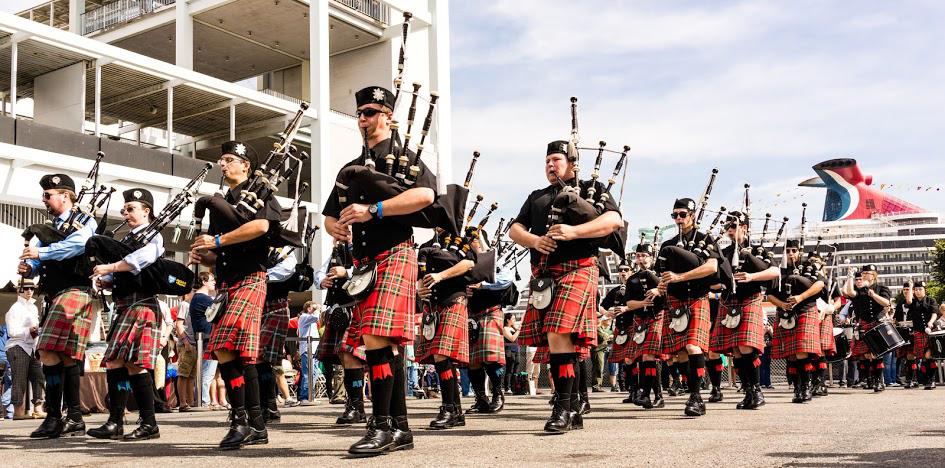Afloat the iconic 1936 ocean-liner-turned-hotel moored in Long Beach might be the last place one would expect to find a plaid sea of kilt-clad clans tapping their ghillies to blaring bagpipes and tossing 20-foot cabers.
Queen Mary traded her sunbathing seals for sheep-herding demonstrations on Saturday at the 22nd annual Scotsfestival, the longest running annual event, according to Steve Sheldon, director of events at the Queen Mary.
“The music, the whiskey and the craic—the friendliness—are what bring us out today,” Michael O’Donoghue, a festival-goer, said while spectating the sheaf toss competition, head-to-toe in Celtic garb with traditional, evergreen Irish tartan. “Everyone feels open enough to walk up and talk to you about what you’re wearing; you can’t come here and just be closed off.”
Traditional wool-woven skirts and their cross-hatched designs have extended beyond the post-romantic era of Highland-dress code into the modern age of liberty-spiked punk rockers and on the racks of stores like Forever 21 and Hot Topic.
Although they originally served as a military insignia to earmark troops, tartans eventually became the unifying crest for Scottish clans of the early 19th century.
“[Tartans] are very uniquely related to Scottish culture—funny thing is, they’re not even from [Scotland],” Edward Grant Ries of Clan Wallace said, explaining that the fabric predates the time of Christ and was transferred over—along with bagpipes—by the Romans to the British Isles.
Ries cited clan-culture as a possible explanation for the overbearing Celtic importance of ancestry.
Under clanship, genes didn’t decree authority. Instead, leadership transposed to a clan member best suited to protect the family’s interest, juxtaposing the widely practiced system of monarchy at the time.
“The problem with [clanship] is that it led to a lot of divisiveness and separation; the Scots could never pull together—which is still true—because of this “clannishnes,”” Ries said. “And yet the “clannishnes” is what has enabled them to preserve their culture because of all the stories and jealous prerogatives that they had.”
In fact, through genealogy, Ries discovered that his wife, Elaine, to whom he had already been happily married for several decades, was his seventh cousin. They shared a grandmother in Clan Wallace.
“Willy Wallace was really the inspiration for freedom in Scotland and around the world,” Ries said, citing Wallace’s revolt against English oppression in the 13th century and the post-mortem rebellion that ensued after he was slain by the English.
“We’re not fighting for glory or honor or riches—only for freedom; it’s the one thing that an honest man should not give up except at the peril of his own life,” Ries paraphrased from the 1320 Declaration of Abroath. The document was penned after England’s attempt to establish authority over the land, triggering the first war of independence in Scotland.
“Those words ring uncannily familiar to us [as Americans],” Ries said.
Scots experienced a century of forced displacement beginning in the 1700s known as the Highland Clearances. Host countries adopted the uprooted culture of the deported and displaced Scots, with especial influence on Canada, Russia, New Zealand, Australia and America, according to the BBC.
“The context of the effect of Scottish culture on America is huge,” kilt-maker Susan Rose of the Gordon Clan said. “All but four of the presidents of the United States come from Scottish heritage.”
Rose explained how the English sent military commanders to divvy up the Highlanders, shipping the burliest men to Australia while those with exceptional whit landed in the United States. Some of these refugees included Alexander Graham Bell, Allan Pinkerton of the Pinkerton National Detective Agency and John Muir.
“When you look back in Scottish-American history—literally all of the engineering has been done by displaced Scots. The American Revolution was won by displaced Scots,” Rose said. “They didn’t want to lose this country too, so they had an axe to grind.”
Her scarlet locks brushed the top of an intricately woven sash, plush in polychrome and synched at the top by a bejeweled broach.
“Most tartans when you look at them are very male looking; it’s a military uniform. It’s not for females,” Rose said. “So when you come across one that’s for the ladies. If they could dress their women, that means they had money.”
Her lineage traces back to Clan Gordon, a sect best known for its affluence and domination of the north.
“The chief of Clan Gordon would be called the cock of the north in every term that you can imagine,” Rose said. “He had his own 3,000 standing-man army when the king did not have a 3,000 standing-man army. He was one of those guys.”
Rose described her job as a kilt-maker of 26 years as an honor in carrying on Scottish-American traditions, having designed most of the attending bands’ kilts.
“What [the festival] does is tie everybody together; we’re called a diaspora,” Rose said. “We are a people without a country. We’re Americans, but we didn’t come from America. This is our way of collectively coming together.”
Scotsfestival at the Queen Mary is the first of the season, acting as the kick-off to the larger expo called the Seaside Highland Games held in October. The autumn fair is about five-times larger with almost 100,000 attendees, according to John Lowry, chief of the Seaside Highland Games of Clan Gordon descent.
Lowry carries on his Scottish heritage through heavy involvement in various organizations and boards with a shared mission of progressing Celtic tradition. Although he said he enjoys the athletics and Whiskey deluge, he is partial to the music.
Sitting by a quintet of stringed-instrument musicians, Gina Thornburg, an attendee from Woodland Hills, couldn’t agree more.
“My great grandparents still kept the Irish culture going [by] still singing, playing the music and dancing,” Thornburg said above the sweet songs of the violins, contrasting the faint nasal-noted bagpipes droning in the distance. “For me, it’s about getting together as a community to forget your troubles and to celebrate life with all of its imperfections and all of its beauty.”




